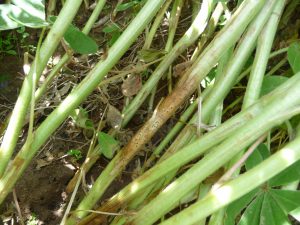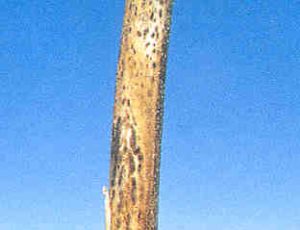This disease is caused by the fungus Diaporthe toxica. Infection can cause minor crop losses; however, the major impact of infection is the production of a mycotoxin (phomopsin) in mature lupin stems. The toxin can cause sickness or death (lupinosis) of stock that graze infected lupin stubble or seed.
What to Look For
The fungus can infect stems, leaves, pods and seed of lupins. Prematurely dying plants after pod set can be seen in crops and are found particularly in parts of the paddock that are stressed by drought, frost or herbicides.
Symptoms usually appear on senescing lupin stems and are the appearance of dark purplish lesions that bleach with age and contain black fruiting bodies and can cause plants to lodge. The appearance of disease symptoms while plants are green is uncommon. Infected seedlings develop deep-yellow to brown, irregular shaped lesions on their stems below the cotyledons. Severe lesions may girdle the stem and kill the plant. Sometimes, yellow to brown blotches are visible on the leaves and stems of older plants (Figure 11.5), but most infected plants show no disease symptoms until late in the season at senescence. The surface of green pods can become ‘slimy’ and mature pods may be shrivelled with reddish-tan to black lesions.

The early formation stages of a Phomopsis stem lesion on albus lupin. (Photo – Kurt Lindbeck NSW DPI)
Pod lesions can lead to infected seeds which appear as either normal or are discoloured light yellow to reddish-tan. Web-like grey mould of the fungus may be seen on the seed coat and inside the seed pod.
The disease will most likely be seen on lupin stubble. Small black fruiting bodies develop, often after summer rain which stimulates growth of the fungus and the production of toxins. Once this occurs care should be taken when grazing stubbles for risk of livestock poisoning.
Disease Cycle
The fungus can survive on lupin trash and seed. On trash, the fungus can remain viable for several years. The disease usually becomes established when spores produced on old lupin stubble are carried by wind and rain into new crops. Infection can occur at any stage of plant growth if conditions are favourable for the disease.
Sowing infected seed may give rise to infected seedlings. Sometimes these develop severe stem lesions and die shortly after emergence. Plants that do survive often lack vigour and may lodge. Occasionally spore producing lesions form on infected plants while they are still green, often following a period of moisture stress.
Management
Prolonged rainfall or high humidity in late spring and summer can favour the pathogen and some toxicity may still develop requiring care to be taken when grazing occurs.
Paddock Selection
Crop rotation is an important management strategy and increasing the break between lupin crops allows weathering and breakdown of infected stubble, reducing disease inoculum. Don’t sow lupins in the vicinity of old infected lupin stubbles. Infected crop residues should be destroyed by deep ploughing or burning.
Resistant Varieties
In areas where lupinosis has been reported, only Phomopsis resistant lupin varieties should be grown (Table 11.1). Variety selection is an important management strategy and an effective way of reducing phomopsis. Current varieties have moderate levels of resistance to both stem and pod infection.
Seed Treatment
Use disease-free seed.




